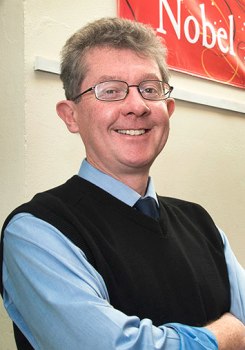Over the last decade, one of the most sensational findings in the field of condensed matter physics is the presence of "topologically protected" electrical conductivity on the surface of certain materials, whose bulk interior behaves as an insulating material, resulting in new potential applications and various unusual electronic states. Most of these phenomena, however, have not yet been studied properly.
 Séamus Davis
Séamus Davis
Brookhaven National Laboratory researchers have now carried out an atomic-scale study of the surface characteristics of a ferromagnetic topological insulator which indicate that these materials are not exactly what they appear.
The research work published in the Early Edition of the Proceedings of the National Academy of Sciences discussed about the changes in the fundamental principle of surface electrons called as the "Dirac mass." Dirac mass is a result of interaction between the surface particles with the magnetic fields. These fields are generated while substituting the magnetic atoms in the material's crystal lattice to transform into a ferromagnetic topological insulator.
The exotic surface state was broken down as a result of the chaos in the ferromagnetic topological insulators.
Under the supervision of Davis, Brookhaven Lab postdoctoral researchers Chung Koo Kim and Inhee Lee studied the nearly perfect ferromagnetic topological insulator crystals developed by Brookhaven physicist Genda Gu. The researchers used scanning tunneling microscope and spectroscopic imaging designed by Davis at Brookhaven to scan the crystal surface atom-by-atom. This tool is capable of precisely indicating the positions of the magnetic dopant atoms and the resulting Dirac mass.
What we have discovered is that the Dirac mass is extremely disordered at the nanoscale, which was completely unanticipated. The analogous situation in elementary particles would be if the Higgs field was random throughout space so that the electron mass (and the mass of a car or a person) was randomly different at every location. It would be an extremely chaotic universe.
Senior physicist at Brookhaven Lab, J.C. Séamus Davis
The scientists initially thought the magnetic dopant atoms do not influence the topological surface states. However, no detailed study was carried out on the detrimental effect of spatial arrangements of the magnetic dopant atoms at the atomic level, on the Dirac-mass, due to the lack of reliable techniques.
Our findings explain why many of the electronic phenomena expected to be present in ferromagnetic topological insulators are in fact suppressed by the very atoms that generate this state, and offer insight into the true atomic-scale mechanism by which the observed properties arise. This new understanding will likely result in revisions of the basic research directions in this field.
Senior physicist at Brookhaven Lab, J.C. Séamus Davis
The novel atom-by-atom SI-STM data of crystals showed that the intense nanoscale disorder is based on the variations in the density of the magnetic dopant atoms on various parts of the crystal surface. It also revealed the first direct evidence for the actual mechanism of surface ferromagnetism in a topological insulator and determination of the strength of surface-state magnetic-dopant interactions.
The Dirac-mass 'gapmap' technique introduced here reveals radically new perspectives on the physics of ferromagnetic topological insulators. The key realization from these discoveries—aside from a clear and direct picture of what is going on at the atomic scale—is that, in ferromagnetic topological insulators dominated by this magnetic-dopant atom phenomena, many of the exotic and potentially valuable phenomena expected for these materials are actually being quantum mechanically short circuited by the random variations of Dirac mass.
Senior physicist at Brookhaven Lab, J.C. Séamus Davis
If scientists can develop various ways to control the dopant-induced Dirac-mass gap disorder, there can still be several ways to identify exotic properties of the ferromagnetic topological insulators. The research was supported by the Office of Science of the U.S. Department of Energy and funded by the DOE Office of Science.
References